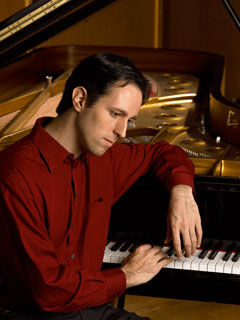by Mike Telin

On Monday, July 6 at 7:30 pm in Ludwig Recital Hall at Kent State University, Spencer Myer and the Miami String Quartet will present a Kent/Blossom Faculty Concert that will feature Ernest Chausson’s Piano Quartet in A, Op. 30, and Béla Bartók’s Piano Quintet. The concert will also include Joseph Haydn’s String Quartet No. 5 in f.
Written in 1897 and premiered the following year, Chausson’s seldom-heard Piano Quartet lasts approximately forty minutes. Bartók completed his relatively unknown Piano Quintet seven years later in 1904, and it too has an average duration of forty minutes. “They’re huge,” the Northeast Ohio native said with a chuckle during a telephone conversation, adding that both works are new to his repertoire.
“I was very excited to find out they were programming the Chausson. First of all, I love the music of the French Impressionists, and he brings a bit of that language to his music, but it’s also leaning back into the Romantic era.”
As much as he enjoys playing the music of Chausson, Myer said that he does find it challenging. “It’s similar to Fauré in that the harmonies are changing almost every measure, or even every half measure. And those changes often go in directions that you don’t expect them to go. It’s not so jarring that listeners would pick up on it on a first hearing, but as a performer, reading and absorbing music like this is very challenging, because the harmonies are shifting so often. But it is gorgeous music. There’s a meatiness in his music that you don’t find in Debussy, Ravel and Fauré. It has big moments of lush melodies and harmonies, and this is what I think harkens back to the Romantic era as opposed to true French Impressionist music.”
Myer said that another challenge to playing the music of Chausson is that it is not always idiomatic. “I often wonder what kind of a pianist he was, because there is some awkwardness. There are a lot of sections that are not as pianistic as some of the music we know of Debussy and Ravel and Fauré, who were all very good pianists. But in a lot of places it is extremely virtuosic.”
In program notes for Bartók’s Piano Quintet, Dr. Richard Rodda writes:
The Piano Quintet summarizes the training and sympathies of Bartók’s youth: its ambitious scale, motivic development and full textures may be traced to the chamber music of Brahms, its cyclical procedures and thematic transformation to Liszt’s tone poems and Piano Sonata, its opulent harmonies to Strauss (and even in a few passages to Debussy), and its folkish melodies to the Gypsy fiddlers of Budapest’s cafés and the small towns of his childhood.
“The first time I listened to the piece I looked down at my iPod because I was certain I had the wrong track. It really just doesn’t sound like the Bartók we know. It’s harkening in part back to Brahms,” Myer said. “Some composers that come to mind when you think of such drastic changes from early to late are Beethoven and Ligeti , but I never realized that early Bartók sounded like this. I also did not know the piece existed, because we are so often bombarded by the five or six standard works by him. And it seems to have been written before he was diving into the folk element. There are some folk elements, especially in the faster movements, but by and large it is steeped in the late Romantic tradition.”
When learning two pieces as big as these, how does Myer plot out his daily work plan? “I’ve always been a pretty good sight-reader from the time I was very young, so I have gotten into the habit of learning the notes quite quickly and getting a broad sense of a piece. Then I go back and do the careful work of filling in the details. For me this is a good way to work, so in the early stages of learning a piece I don’t get stuck on one or two measures — I try to exercise my reading skills and develop the big sense of a piece.”
In addition to Monday’s concert, Myer looks forward to coaching two Kent/Blossom student chamber music ensembles. “I’m here for two weeks this year, and I’ll be coaching the Ludwig Thuille’s Sextet for Piano and Wind Quintet. It’s a really charming piece that I’ve played a couple of times with the Dorian Wind Quintet. I’m also coaching the Schumann Piano Quartet. I love coaching. Most of the teaching and master classes I do is obviously with solo pianists, so it’s great to have the chance to work with piano chamber music. It’s going to be a lot of fun.”
Published on ClevelandClassical.com July 1, 2015.
Click here for a printable copy of this article



